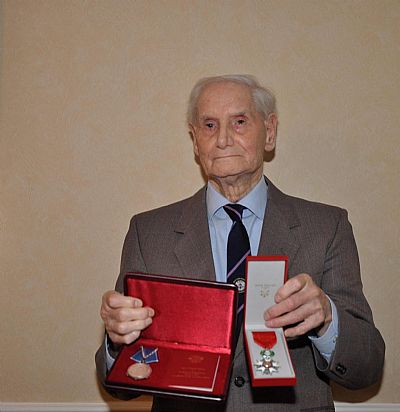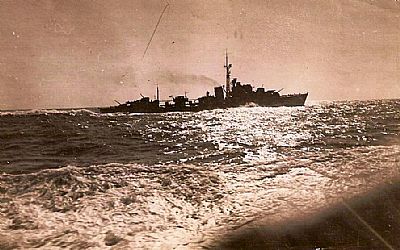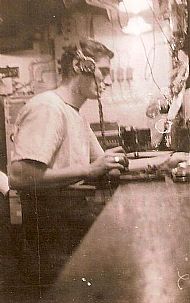ERNIE IN WW2
French medal Rank of Chevalier (Knight)
order legion d'honneur and Ushakov Medal
A war hero from Hartford has been awarded the highest French honour possible for his bravery and courage during the D-Day Landings.
Second World War veteran Ernie Nelson has been presented with the the French medal Rank of Chevalier (Knight) order legion d'honneur for his role in the events that liberated France and Europe in 1944.
The 91-year-old was a wireless telegraphist on HMS Scourge, which was part of the ill-fated 23rd Destroyer Flotilla that spearheaded the D-Day Landings of June 5 and 6, 1944, and lost two of seven ships.
HMS Scourge played a key role in the landings, including protecting minesweepers to cut passageways through the German minefields, bombarding Sword Beach, including Ouistreham, and bombarding Omaha Beach with HMS Saumarez to support American troops.
This allowed the Americans to escape the beach and head to the top of the bluffs.
HMS Scourge also bombarded Gold beach and came under air attack from two separate German Junkers 88 dive-bombers.
Last year Ernie, who lives in Hartford with his wife Constance, also received the highest Russian honour, the Ushakov Medal, for his bravery and courage on the Russian Arctic Convoys.
He completed 12 Russian Arctic convoys in two years.
Winston Churchill described the Russian Arctic Convoys as 'the worst journey in the world'.
The convoys were known at the time as suicide runs, suffering German submarine and air attacks in sub-zero temperatures to provide supplies to Russia.
When he accepted the legion d'honneur from French Consul Mme Aude Auclair Ernie paid tribute to the crew of HMS Scourge.
"It is through their bravery and great skill in action that I have been awarded these medals and I will never forget them," he said.
Ernie went on to serve nearly 12 years in the Royal Navy and saw action all over the world.
He was also awarded a personalised Palestine War silver medal.

Visit to Normandy 2009
for the 65th Anniversary of the D-Day Landings
Ernie Nelson visited Normandy, France in 2009 for the 65th anniversary of the D-Day Landings. This was the first time Ernie has been back to Normandy since the D-Day Landings that liberated Europe in 1944. The highlight of his visit was the Royal Naval War Memorial at Hermanville on Sword Beach. It was originally intended for the men who died on the 23rd Destroyer Flotilla. It is now being used as a war memorial for the Royal and Merchant Navy personnel as well as the 23rd Destroyer Flotilla that were killed in Normandy.
Ernie was a wireless telegraphist on HMS Scourge and part of the famous ill-fated 23rd Destroyer Flotilla. The flotilla spearheaded the D-Day Landings on the 5th and 6th June 1944. The following pages include what HMS Scourge did during the run up to, and on, 6th June 1944 D-Day Normandy Landings.
HMS Scourge

HMS Scourge was one of seven ships in the 23rd Destroyer Flotilla. The flotilla paid a heavy price during the D-Day Landings. Two out of the seven ships, the HMNS Svenner and HMS Swift were sunk in action. The HMNS Svenner was the first ship sunk and was the only ship sunk by the German navy during the D-Day Landings. Torpedoes fired by German E-boats based at Le Havre sank HMNS Svenner. Later a German parachute mine sank HMS Swift.
HMS Scourge performed a key role during the D-Day Landings including protecting the minesweepers to cut passageways through the German minefields, bombarding Sword Beach including Ouistreham and bombarding Omaha Beach with HMS Saumarez to support the American troops. These actions allowing the Americans to finally exit the beach to the top of the bluffs. They also bombarded Gold beach and came under air attack from two separate German Junkers 88 dive-bombers.
23rd Destroyer Flotilla was Chosen to Spearhead the Normandy Landings
The 23rd Destroyer Flotilla consisted of seven fleet destroyers was chosen to spearhead the Normandy Landings. They had built an impressive record on the Russian Arctic Convoys, especially on Convoy JW55b when the battleship cruiser Scharnhorst attacked the convoy.
When the Scharnhorst attacked, HMS Scourge and one of her sister ships stayed with the convoy of merchant ships. They were hoping that the Scharnhorst did not break through to the convoy. Ernie was listening to British Admiralty messages for the entire duration of the Battle of North Cape.
Four sister 23rd Destroyer Flotilla fleet destroyers took part in the Battle of North Cape. They had a faster top speed than the Scharnhorst. The fleet destroyers moved in close, firing torpedoes, which crippled and stopped the Scharnhorst escaping from the larger British battleships. The battleship HMS Duke of York finally sank the Scharnhorst.
HMS Scourge’s crew were already battle-hardened veterans of five Russian Arctic convoys and many would finish the war completing an impressive twelve Russian Arctic convoys.
Spithead, Isle of White Naval Base
On the 4th June 1944, the signal ‘Neptune Soldier’ was sent to the ship by special landline telephone. The ship was sealed and the Normandy Landings operation was outlined to some of the crew.
At approximately 11.15, on the 5th June the ship was given four hours to get ready to sail to Normandy.
It is believed that HMS Scourge was the first destroyer to leave the naval base at Spithead, Isle of White, at approximately 15.35 on the 5th June. It was followed by her sister ship HMS Seraphis.
Passage Through the Minefield to Normandy
HMS Scourge was part of Task Force S Flotilla. It was to escort the minesweeper to clear passageways to Sword Beech on the left flank of the Allied British D-Day Landings. This would enable the rest of the ships to use these mine free passageways to arrive as close as possible to the beach. The minefield was marked and some of the mines were cut from the seabed by two-man midget submarines that were sent out ahead of the minesweepers.
HMS Scourge sailed in the middle of four minesweepers, two minesweepers on either side. They were travelling through the minefield very slowly at a speed of approximately three knots. This was particularly dangerous for the fleet destroyer as some of the mines were cut from the sea bottom and floating on the surface. There were at least three mines floating dangerously close HMS Scourge.
The Captain ordered all the ship’s non-essential crew to go to the upper decks in case the ship hit a mine. Ernie was in the wireless communication room and was classed as essential staff. He only found out about this order when reading the ship’s logs fifty years later.
The passageways were made more dangerous by the ship’s complete wireless and radar silence. These were switched off to prevent the German’s detecting them. The sonic radar detected the mines. If the minesweepers missed any stray mines the Scourge’s crew would shoot at the floating mines. When hit by gunfire the mines would sink to the seabed.
HMS Scourge was fitted with a blue searchlight mounted on the stern of the ship. This light was a guide for the following ships, marking out the safe passage through the minefield.
Passage to Sword Beach
At approximately 02.40, HMS Scourge completed the task with the minesweepers and moved from the mine swept channels with her sister HMS Scorpion closer to Sword Beach.
HMS Scourge was therefore one of the first ships to arrive off the Normandy coast on the 6th June.
As the destroyers moved towards Sword Beach two midget submarines surfaced. If they had remained underwater the British destroyers may have depth charged them thinking they were German submarines.
It is believed that the midget submarines part of the operation in the channel was carried out on the 4th June. This was the day before the Operation Overload Supreme Commander had given the orders to start D-Day Landings.
Ernie in the wireless communications room.

Sinking HMNS Svenner
As the destroyer flotilla reached Sword Beach they came under attack from a number of German motor torpedo boats based at Le Havre.
The motor torpedo boats fired torpedoes and one destroyer managed to manoeuvre out of the way. The torpedoes passed on either side of the ship. HMS Scourge’s 23rd Destroyer Flotilla Norwegian sister ship HMNS Svenner was not that lucky. At approximately 05.30, HMNS Svenner was hit by two torpedoes amidships breaking her back and began to sink immediately. HMS Scourge’s sister ship HMS Swift without authorisation altered course and without stopping the ship’s engines picked up some Norwegian sailors from the sea.
There were approximately 48 casualties dead and wounded, but this would have increased immensely if it weren’t for HMS Swift’s intervention.
HMS Scourge was approximately 500 yards from HMNS Svenner when it was sunk, but obeyed orders and remained in position.
The destroyers engaged the German motor torpedo boats as these quickly turned back towards Le Havre. They did not emerge again during the D-Day Landings.
Ernie met an HMNS Svenner survivor several years later. He was in a wheelchair having lost a leg and eye during the D-Day Landings.
There is a Norwegian War Memorial at Hermanville on Sword Beach for the HMNS Svenner’s crew killed during the D-Day Landings. This is approximately 100 yards from the original war memorial for the 23rd Destroyer flotilla sister ships HMNS Svenner and HMS Swift. Ernie left two wooden crosses and two messages one for each ship sunk when he visited Normandy during the 65th anniversary of the D-Day Landings. The Royal Navy took over the original war memorial and included all the British ships sunk during the D-Day Landings. The Norwegians decided to build a separate War Memorial for HMNS Svenner.
Bombarding Sword Beach
HMS Scourge’s bombarding position on Sword Beach during the opening salvos was in the middle of approximately ten destroyers.
A Royal Artillery Captain acted as the ship’s Shore Spotter. Ernie had spoken to him several times on HMS Scourge’s Bridge before the D-Day Landings. He left HMS Scourge and went ashore with the Suffolk Regiment on the first wave at Sword Beach. His task was to carry a wireless transmitter and guide the destroyer’s shells to their targets.
The Shore Spotter was in contact with HMS Scourge’s wireless communication room, which would relay the morse code messages to the ship’s Bridge. The ship then fired shells at their defined targets.
One of HMS Scourge’s first land targets was the Hotel believed to be at Ouistreham. This was full of German snipers and preventing British troops from advancing inland. HMS Scourge fired at the Hotel, guided by the Royal Artillery Shore Spotter. The morse code message came back from the Shore Spotter indicating that HMS Scourge had hit the Hotel on her first salvo. HMS Scourge fired approximately 140 shells at the Hotel and surrounding areas of Ouistreham.
The film ‘The Longest Day’ shows the Ouistreham Hotel, next door to the Ouistreham Casino captured by French commandos.
The film shows the Hotel still standing, however Ernie’s memories backed up by HMS Scourge’s logs were that it was flattened early in the morning on D-Day.
The Ouistreham Casino was not recognized as a target by HMS Scourge’s Royal Artillery Shore Spotter.
The Shore Spotter was one of the most dangerous roles during the D-Day Landings. Carrying a wireless transmitter on their backs the Shore Spotters were the first targets for German snipers. The Shore Spotters role was to direct the destroyer’s gunfire onto the German inland targets.
Sadly the Royal Artillery Captain aged in his late twenties who was spotting for HMS Scourge was wounded, and later died in Normandy. Ernie believed that another person took over his wireless transmitter. It is also believed that this person who took over was either killed later or the wireless transmitter damaged and unable to transmit.
Bombarding Omaha Beach
When Ernie visited Normandy for the 65th anniversary of the D-Day Landings he clearly recognised the bluffs on Omaha Beach. The destroyer he was on, HMS Scourge was at Omaha Beach during the D-Day Landings on 6th June 1944.
The American landings were going badly at Omaha Beach, troops and equipment were causing congestion as they piled upon the beach. The American casualty count was increasing at an alarming rate. The troops could not move off the beach due to the strong gunfire from the Germans located on the bluffs above the beach.
It is believed that the American Commander at approximately 08.30 was considering abandoning Omaha Beach. He asked the British, if the Americans could use one of the British beaches to land the American troops and equipment.
HMS Scourge had agreed the bombarding targets for the morning with the Forward Observer, when it received an emergency signal. The 23rd Destroyer Flotilla leader HMS Saumarez sent an emergency morse code message by signal lamp. The message was sent directly to HMS Scourge’s Bridge. Generally the message read that the Yanks (Americans) were having trouble at one of their beaches and HMS Scourge would join HMS Saumarez to provide assistance.
The American beach was code named Omaha.
It is believed that the British Admiralty in London sent the message to HMS Saumarez. HMS Saumarez was the flotilla leader and to change orders and go to Omaha Beach would have come from the highest level in British command. The only persons able to over-ride or change orders to HMS Saumarez during the D-Day Landings were either the Eastern Task Force Rear Admiral or the Admiral. The Admiral was on a higher command level than the American Commander and was only one command layer below the Operation Overload Supreme Commander.
HMS Scourge and HMS Saumarez broke away from their pre-planned bombarding berths and the other destroyers on the British beaches. The two British fleet destroyers proceeded to Omaha Beach at approximately 08.55.
The two British fleet destroyers kept a look out for any mines in the un-swept channels on the way to Omaha Beach.
HMS Scourge and HMS Saumarez arrived at Omaha Beach and started making smoke. This was to protect themselves and the Americans landing crafts from German shore fire from the bluffs.
The two Britsh fleet destroyers had trouble selecting targets and moved closer towards the Omaha Beach to approximately 500 yards from the beach. The fleet destroyers had shallow draughts, but in the shallow waters the fleet destroyers could run aground, losing their ships and risking the lives of their crew. The fleet destroyers found it difficult to manoeuvre quickly in the shallow waters and continued to make smoke where necessary.
HMS Scourge fired 4.7-inch diameter special concrete bunker piercing shells at German targets. It is believed that HMS Saumarez was also firing these types of shells.
As they moved closer to the shore HMS Scourge was attacking German shore targets such as pillar-boxes, howitzers, mortars and machine gun nests. The gunners were very accurate as both British fleet destroyers were veterans of the Russian Arctic conveys.
Later during D-Day certain members of the crew on the Bridge said that in their opinion the ship went too close to the shoreline. The gamble to go closer to the beach paid off.
The German incoming fire towards HMS Scourge was considered inaccurate and poor as the fleet destroyer went closer to the shore. Despite the Germans firing a number of shells from the bluffs only two shells fell close to HMS Scourge. The German shore guns were having difficulties finding the range of the two destroyers. HMS Scourge suffered one minor casualty from the German shells. A sailor located at the rear gun turret was hit in his face by shrapnel providing him with a souvenir of Omaha Beach.
After approximately 09.50, the two British fleet destroyers had silenced some of the German onslaught from the bluffs. This allowed a small number of American troops to exit the beach. The two British fleet destroyers provided cover for bulldozers to clear the beach of personnel and anti-tank obstacles. The bulldozers were American made. However it is unclear whether the bulldozers operatives were British and if the flotilla leader HMS Saumarez commanded them.
It is believed that two safe passageways were cleared on the beach. This allowed American tanks and troops to move up and exit the beach.
Much later during the morning an American destroyer arrived. It is believed that it was joined later by at least three or four other American destroyers at Omaha Beach.
The differences between British and American destroyers on D-Day were that the two British fleet destroyers had one funnel and an open Bridge. The American destroyers had two funnels and a closed Bridge. The difference between the two British fleet destroyers was that HMS Saumarez had a black band on the funnel identifying that it was the flotilla leader where HMS Scourge had a plain camouflage funnel.
It is believed that the American destroyers were in wireless morse code communication with the troops landing on Omaha Beach. They provided shells on targets determined by the Shore Spotters.
HMS Scourge and HMS Saumarez continued patrolling Omaha Beach selecting shore targets throughout the morning. HMS Scourge and HMS Saumarez left Omaha Beach at approximately 12.23. By then the Americans were able to move troops and equipment on and off the beach without the constant threat of gunfire.
HMS Scourge logs show that they fired approximately 400 shells during the D-Day Landings that were uncounted for. It is believed that these shells, which were concrete bunker piercing shells were fired at Omaha Beach up to approximately 12.23. HMS Scourge’s fire accuracy was considered good as shells hit shore targets observed by the ship. Other targets inland were obscured. It is believed that HMS Saumarez fired a similar number of shells and their accuracy was considered good at Omaha Beach.
The actions of HMS Scourge and HMS Saumarez helped save many American lives and helped to turn the tide at Omaha Beach on the morning of D-Day 6th June 1944. If Omaha Beach were lost there would had been a gap between the British / Canadian and American beaches. This gap between British / Canadian and American beaches would have affected the entire success of the D-Day Landings.
However, Hollywood and some historians have written these incidents out of history. Very few veterans know that two British fleet destroyers moved in close to the shore firing shells pounding German positions at Omaha Beach. The two British fleet destroyers helped to enable American tanks, troops and equipment exit Omaha Beach.
There are a number of American documentaries and original newsreels of Omaha Beach clearly showing the two British fleet destroyers. Several American documentaries show HMS Scourge and HMS Saumarez firing shells at the bluffs. HMS Scourge making smoke close to Omaha Beach. HMS Scourge in the middle of American landing crafts on their way to Omaha Beach. There are American newsreels showing a close up of a fleet destroyer on Omaha Beach with the clear markings ‘G01’, which is HMS Scourge’s identification number. Photographs taken of HMS Scourge during the D-Day Landings clearly show that this ship has the same camouflage as the newsreel. There are American newsreels of Omaha Beach showing US troops sheltering at the sea walls, a US marked landing craft in the foreground and the two British fleet destroyers in the background.
It is believed that these newsreels were filmed from American landing crafts and from Omaha Beach. A famous Hollywood director at the time was given the task of filming the American’s D-Day Landings. It is believed that he and his staff filmed these and several other sightings of HMS Scourge on Omaha Beach.
The American film archives show the two British fleet destroyers, but it is believed that these events do not appear in official American document archives, because the two British fleet destroyers remained under British command throughout.
It is believed that the two British fleet destroyers do not appear in any British film archives.
HMS Scourge’s crew considered this action on one of the Normandy Beaches as only a minor incident compared to the action they had seen on the Russian Arctic Convoys. However, world history considered this action by HMS Scourge and HMS Saumarez as being one of the major turning points to help the Americans secure Omaha Beach during the D-Day Landings.
Ernie’s memories, historical research, HMS Scourge’s logs and original archive American films clearly indicate that HMS Scourge and HMS Saumarez were on Omaha Beach during the D-Day Landings between approximately 08.55 and 12.23. This action helped the American troops to move off the beach to the top of the bluffs during the D-Day Landings.
Afternoon Bombarding
HMS Scourge left Omaha Beach at approximately 12.23 and arrived at bombarding position k7 berth at approximately 13.00. The ship had no further calls for fire that afternoon. At approximately 17.15, HMS Scourge has a signal from HMS Saumarez to get ready for patrol duty covering the British beaches.
D-Day Aircraft attack
At approximately 22.40, HMS Scourge started to patrol the British beaches.
At approximately 23.05, a German Junkers 88 dive-bomber attacked the ship, two bombs fell too close for comfort, just missing the ship’s stern. The bombs estimated at 500 pounds landed in the ships wake and on the quarter of the ship. The ship shuddered.
Again at approximately 23.33, German Junkers 88 dive-bomber dropped a stick of six bombs that straddled the ship. Three bombs fell on each side of the ship. The bombs on each side were extremely close and the fourth bomb on the starboard side drenched the Bridge with water.
Somehow the ship had turned and survived in the middle of the stick of six bombs. The bombs passed HMS Scourge’s mid-ship. Wireless telegraphists were classed as essential staff and Ernie was at the time of the incident in the wireless communication room. This was located on the lower deck below the Bridge and put Ernie directly in the middle of the stick of six bombs. As the bombs exploded in the water dust fell over wireless equipment from the ship’s deck head and bulkhead. If the bombs were five or ten metres either way and hit the ship his chances of survival would have been very slim. HMS Scourge had no casualties despite shrapnel fragments hitting the ship at several places. HMS Scourge’s luck had held.
As the German’s aircraft attacked Air Borne troops were passing above and the German aircraft was seen very late. HMS Scourge did not return fire, as they did not want to hit the Air Borne troops above.
The two incidents relating to aircraft attacks taken from HMS Scourge’s logs have appeared many times in D-Day books and the ‘Royal Navy News’ magazine.
HMS Scourge was known as a lucky ship on the Russian Arctic convoys and the D-Day Landings also confirmed that her luck would continue.
HMS Scourge was joined on patrol with HMS Scorpion until approximately 08.30 on the 7th June.
The action details for HMS Scourge’s is during the run up to and on D-Day 6th June 1944. There are many other incidents that occurred to the ship up to their release from Operation Overlord on 30th June 1944.
